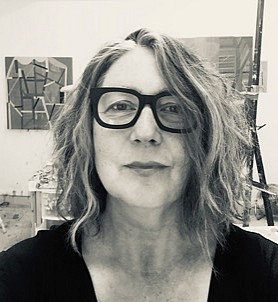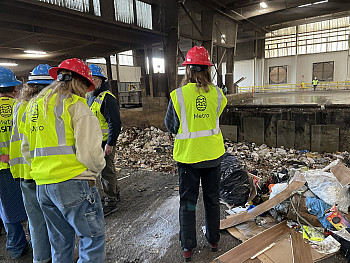main content From Trash to Treasure: Creating Art From Waste
Cara Tomlinson’s Art and Ecology class uses waste materials from around Portland to create beautiful and meaningful works of art. This course offers a fresh approach to creative practice, merging art and ecology to help students respond to the climate crisis, explore the agency of materials, and build connections to place.
Place-Based Learning

Tea Bag Tapestry
Eliza Roberts BA ’25 focused on tea bags and their packaging—filter paper, tags, strings, and foil wrappers—as part of her daily waste stream. Over two weeks, she saved these materials to create a tapestry of fused filter paper, which serves as the base for an ink illustration of a factory, layered over a quilted pattern of foil and tags. “During this process, I considered the production of tea bags, the colonial roots of such practices, the adverse environmental effects, and the ultimately menial convenience tea bags actually provide.”

Underwear Quilt
Lucy Swedberg BA ’25, who works in textiles, sourced materials from Goodwill bins, focusing on the most undesirable item: underwear. Sewn together like puzzle pieces, the washed undergarments form layers that mimic Earth’s soil, ice, and sediment—proxies that reveal the planet’s history. “The underwear quilt is a testament to our unfortunate and inevitable future of a waste-filled earth.”
by Zoey Keepper BA ’26
In a time of accelerating climate change, how can artists pursue creative projects that are in tune with environmental concerns? Art and Ecology, a 200-level course, offers a novel approach by intertwining art and ecology, guiding students to reimagine their creative practices through the lens of sustainability and place.

Tomlinson encourages her students to use a zero-waste lens to forge direct connections to the materials used in creating their art pieces. Consequently, sustainable practices in sourcing materials are important aspects of the class. For one class project, students locate their own art materials in the natural or human-made environment, thus building their understanding of the art-making processes. In one instance, students developed paint pigments from native plants, such as elderberry and buckthorn.
A major theme of the class is creating “threads of reciprocity” within the greater Portland bioregion, including among communities, physical places, and other organisms. The idea of reciprocity refers to the interconnected relationships between people and the natural world. It’s a give-and-take: humans draw inspiration and resources from the land, and in return, care for and honor its ecosystems, recognizing that our lives and actions are deeply intertwined with the environment.
Connections to Campus and Portland
Social engagement is an integral part of the class through field trips to the greater Portland area and what Tomlinson dubs “site interviews,” which promote place-based research. Every student chooses a site that they are encouraged to return to throughout the semester. As an example, some students chose a neighborhood site where they created a community garden and a mini library containing books on gardening.
By returning to the sites and creating relationships with the human and nonhuman actors of the areas, “the idea is that there’s some communication that moves beyond the site that they’re working on,” says Tomlinson.
In their final project, students are asked to “think about the human impact of that site.” Tomlinson calls special attention to the invention of plastic, which has led to a new type of mineral dubbed “Plastiglomerate” found in our current geologic strata. She notes that “plastic has melded with other kinds of earth, sand, and rock to create this new kind of mineral.”

Credit: Cara TomlinsonThe influence that plastic has on the environment is one of the reasons Tomlinson took her students on a field trip to the Portland Metro Central Transfer Station in Oregon City. “We are living in this moment of real excess waste,” says Tomlinson. “Students confront this reality firsthand at the transfer station.”
Tomlinson says that the experience can be loud, intense, and visually overwhelming for students, but that it shows the sheer amount of waste that Portland produces each day. The transfer station takes in a variety of materials, including hazardous, household, and construction waste, and transports it to landfills.
With 3.9 million pounds of waste a day coming out of Portland, “the scale is just kind of mind-blowing,” says Tomlinson.
Mining Waste Projects
From this field trip experience, students are encouraged to identify a product of a waste stream—such as metal, plastic, cloth, or even tea bags—and create a project using that material. Their Mining Waste projects feature connections to the sites where each material was foraged from all around Portland.
Tomlinson believes there are abundant art materials everywhere. “That’s the idea—finding the beauty in all these materials that we just get rid of.”
Lucy Swedberg BA ’25, an environmental studies major and an Earth system science minor, enrolled in Art and Ecology this past fall. “This class has made me think a lot more about the connectedness of everything and the agency that nature has,” says Swedberg. “The Mining Waste project allowed me to give myself space to be creative while also thinking about the environmentalism that I’ve been studying for the past four years.”
Another Art and Ecology student, Eliza Roberts BA ’25, is pursuing a double major in history and studio art. “Since starting this course, I have realized that art can reshape how people perceive their day-to-day life. I have begun to pay close attention to the sounds, smells, and ambient life forces that make up my existence. I also have been thinking much more critically about human interactions with nature—both constructive and detrimental. Art can engage in collaboration, finding caring, mutually beneficial ways to use the resources nature provides.”
An Annual Opportunity
Art and Ecology is usually offered each fall and will next be available for registration in fall 2025. All majors and disciplines are welcome. Future classes will continue to incorporate field trips and outreach to the greater Portland bioregion. Students have also collaborated with the cochairs of L&C’s annual Environmental Studies Symposium to put on student-led workshops, creating useful items like cordage or paper from plastic or invasive plant species.
In the meantime, for anyone looking for a break during the finals, head over to the Lewis & Clark EAR Forest, located behind the Fields Center for the Visual Arts. There, Tomlinson’s Art and Ecology class has a program running based on the “acoustic ecology of Portland’s bioregion,” created from student site interviews with nonhuman actors. Programming runs December 16–20, from 3 to 5 p.m.
More Stories

Toil and Trouble
‘Something Wicked This Way Comes’ to the Main Stage
This spring on L&C’s Main Stage, the theatre department presented a contemporary take on Shakespeare’s Macbeth, a mystifying and twisted tale that explores the relationships between human beings and the natural world through horror, humanity, and the uncanny.

Career Success
L&C Launches New Career Accelerator “Turbocharged” by $5M Commitment
This transformational approach to career readiness will integrate career competencies and work-ready skills into every undergraduate’s academic journey; a commitment from Heidi Hu BS ’85 and Daniel Hsieh establishes an endowment to support it.

Environmental Law Moot Court Team Wins National Championship
Lewis & Clark recently secured its ninth championship at the Jeffrey G. Miller National Environmental Law Moot Court Competition, further solidifying our status as the most successful school in the competition’s history.

L&C Traditions
A Tradition of Connection: L&C’s International Fair Turns 60
For six decades, Lewis & Clark’s International Fair has brought cultures together through food, performances, and community. The run-up to this year’s fair, held March 1, featured a week of festivities, including student-designed meals and a visual history of the fair, highlighting its impact on generations of students.
